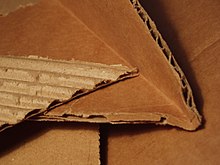A-level Graphic Products/Edexcel/Unit 3 :Designing for the Future/Sustainability/Minimising waste production
This is an in-depth list of the four Rs.
Reduce[edit | edit source]
This is the idea of reducing the amount of materials that are chosen in the first place, before the product is even made.
The benefits of this are:
- Minimisation of the consumption of resources.
- Reduced Cost saving on materials, resulting in improved profit-margins.
Manufacturers are obligated to reduce their material consumption as part of the UK Producer Responsibilities Obligations (Packaging and Waste) Regulations 1997.
This suggests that manufacturers do the following:[1]
- Consider the materials and designs they use.
- Examine ways of eliminating/reducing the packaging required.
- Optimising packaging use, i.e. match packaging to the level of protection needed.
Reuse[edit | edit source]
This is the idea of reusing products that have been manufactured. This is usually because either the material can't be recycled, or that the product has had a lot of time, money and energy put into making it, what it is.
An example of reusing a product is where you can leave a milk-bottle on your 'door-step' and the empty bottle will be collected, cleaned and reused, this saves the manufacturing process, which saves time, money and energy.
Recover[edit | edit source]
This is the concept of burning old products rather than just throwing them in a landfill site, this isn't the ideal solution (waste reduction is) but it's better than throwing it into a landfill. If a product is thrown away then all of the energy put into the object upon creation is wasted.
Waste is incinerated which is a form of heat, this heat can then turn turbines (most likely from creating steam from water) which generates electricity.
Recycle[edit | edit source]
This essentially is the process of breaking down a product, using it's materials to transform it into something new.
Recovering and recycling of paper and board[edit | edit source]

Cellulose fibres found in a variety of plant life can be used to manufacture paper and card.[2] Cellulose can only be recycled so many times as it will break down over time making it become weak. New fibres (virgin pulp from new trees) can be added in with old ones as a way to make it stronger. When the paper/board is recycled it will go through an elaborate grading and sorting system; this is used to get the maximum value obtainable (in terms of fibre).
- Corrugated board
- This is 3 layers of card layered on top of one another, each layer is made from lower grade recycled paper which is why it's often brown and has impurities in the box. The middle layer is special as it goes up and down in the form of a sine wave; this makes it thicker, stronger and more stiff. The strength of this material is dependent upon the quality of the kraft that's imported from abroad.
- Newsprint
- This is the material used for newspaper. It contains the weakest fibres because newspaper has a short lifespan. Newspaper publisher and the government are encouraging the user of a high percentage of newspapers to be made from recycled materials, rather than being wasteful and importing virgin fibres.
When waste paper is recycled, it goes through a series of processes:
- It is collected by local authorities
- Sent to a paper mill
- Hydrapulper (filled with water) is used to make it into a 'slush'
Properties[edit | edit source]
There are three factors to take into account when considering to use waste/recycled paper:
- Strength
- Every time fibre is recycled it loses some strength, so much so, that if you were to keep recycling it would fall apart; roughly the maximum times you can recycle it is around six times.
- Quality
- Some paper can loose quality, this is because they require certain qualities that can only be obtain from new fibres (e.g. smooth and white).
- Utility
- Some paper isn't recycled at all, paper in books stays in books, toilet paper is discarded and some paper is laminated.
The four grades of waste paper[edit | edit source]
| Paper Grade | Characteristics | Sources | Recycled applications |
|---|---|---|---|
| Pulp substitute grades | Top-quality waste paper that can be used with little to no cleaning. | Unprinted trimming and off-cuts from printers/photocopiers | Printing and writing paper |
| De-inking grades | Grades where ink needs to be removed before recycling. | Office waste, newspapers and magazines | Graphic and hygiene material or newspapers |
| Kraft grades | Long string fibres that usually come from unbleached packaging. | Paper sacks | New packaging including corrugates cardboard/packaging |
| Lower Grades | Mix of all types that are not worth sorting as they are too small to make a difference | Junk mail | Middle layers of packaging paper and boards |
Remarkable Pencils Ltd[edit | edit source]
This is a company that has recycled plastic cups from vending machines into pencils and other stationary. One polystyrene cup is enough to make one pencil. They convert 20,000 cups into 20,000 pencils per day. They work on the idea that people are more likely to buy an environmentally clean product, rather than a traditional wooden pencil.
References[edit | edit source]
Note: 'References' isn't one of the four Rs.